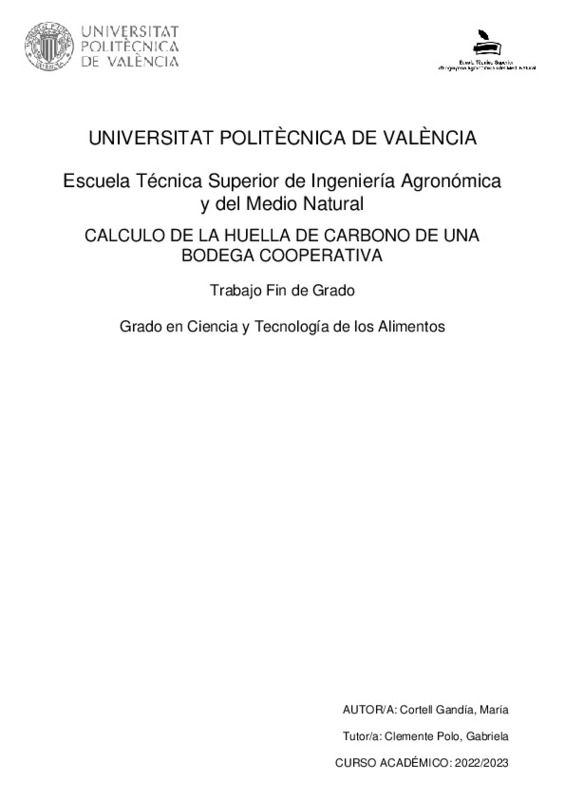JavaScript is disabled for your browser. Some features of this site may not work without it.
Buscar en RiuNet
Listar
Mi cuenta
Estadísticas
Ayuda RiuNet
Admin. UPV
Cálculo de la huella de carbono de una bodega cooperativa
Mostrar el registro sencillo del ítem
Ficheros en el ítem
| dc.contributor.advisor | Clemente Polo, Gabriela
|
es_ES |
| dc.contributor.author | Cortell Gandía, María
|
es_ES |
| dc.date.accessioned | 2023-09-05T07:07:36Z | |
| dc.date.available | 2023-09-05T07:07:36Z | |
| dc.date.created | 2023-07-27 | |
| dc.date.issued | 2023-09-05 | es_ES |
| dc.identifier.uri | http://hdl.handle.net/10251/195868 | |
| dc.description.abstract | [EN] Businesses are increasingly concerned about the impact of their activities on the environment. Climate change is a reality, and among the many possible causes that contribute to global warming are greenhouse gas emissions from human activities. Agriculture and associated food businesses, such as winemaking and bottling wineries, generate emissions and impacts that are harmful to the environment. The calculation of the total carbon footprint of the Winery, or the footprint during each of the processes or on a final product, can be a tool to measure the environmental impact of the Winery. Once the carbon footprint has been quantified, the Winery can study improvements to reduce its carbon footprint and promote sustainable development. To this purpose, this work calculates and compares the carbon footprint of the production processes of a white wine (of three different elaborated wine qualities) and a young red wine (of two different elaborated wine qualities) in a Cooperative Winery. The scope considered is from the time the grapes enter the winery until the wines are bottled. Following the flow diagrams, all the current processes of the Winery and the machinery used with its energy consumption are described, and the CO2 equivalent at each stage is calculated. The methodology proposed for scopes 1+2 of the Guide for the calculation of the carbon footprint and for the elaboration of an improvement plan of a guiding organisation, published by the Ministry for Ecological Transition, has been followed. The actual data on consumption, processes and machines provided by the Cooperative are used, or calculated if they were not available. The study is completed by calculating the carbon footprint per litre or bottle of each elaborated wine. Finally, for the stages of the processes with the highest CO2 equivalent generation, proposals for improvement have been put forward to the winery to reduce their carbon footprint. This work relates to the following SDGs: 8 (Decent work and economic growth), 9 (Industry, innovation and infrastructure), 12 (Responsible production and consumption) and 13 (Climate action). | es_ES |
| dc.description.abstract | [ES] Las empresas cada vez están más preocupadas por el impacto que producen sus actividades en el medio ambiente. Una manera de medir el impacto ambiental es calcular la huella de carbono total de la empresa o de alguno de sus procesos. Una vez cuantificada la huella de carbono, la empresa puede proponer mejoras que permitan disminuirla favoreciendo el desarrollo sostenible. En este trabajo se calculará la huella de carbono de los procesos de producción de vino en una bodega Cooperativa, desde la entrada de la uva hasta que los vinos están embotellados. Para ello se seguirá la metodología propuesta en la Guía para el cálculo de la huella de carbono y para la elaboración de un plan de mejora de una organización propuesta por el Ministerio para la Transición Ecológica. Se utilizarán los datos reales (capacidades de producción, consumo de energía) referentes al proceso de vinificación aportados por la Cooperativa. Finalmente se propondrán mejoras en los procesos para reducir la huella de carbono y se cuantificará la disminución que se puede producir. | es_ES |
| dc.format.extent | 36 | es_ES |
| dc.language | Español | es_ES |
| dc.publisher | Universitat Politècnica de València | es_ES |
| dc.rights | Reserva de todos los derechos | es_ES |
| dc.subject | Carbon footprint | es_ES |
| dc.subject | Huella de carbono | es_ES |
| dc.subject | Bodega | es_ES |
| dc.subject | Sostenibilidad | es_ES |
| dc.subject | Elaboración de vino | es_ES |
| dc.subject.classification | TECNOLOGIA DE ALIMENTOS | es_ES |
| dc.subject.other | Grado en Ciencia y Tecnología de los Alimentos-Grau en Ciència i Tecnologia dels Aliments | es_ES |
| dc.title | Cálculo de la huella de carbono de una bodega cooperativa | es_ES |
| dc.title.alternative | Càlcul de la petjada de carboni d'un celler cooperativa | es_ES |
| dc.title.alternative | Calculation of the carbon footprint of a cooperative winery | es_ES |
| dc.type | Proyecto/Trabajo fin de carrera/grado | es_ES |
| dc.rights.accessRights | Abierto | es_ES |
| dc.contributor.affiliation | Universitat Politècnica de València. Departamento de Tecnología de Alimentos - Departament de Tecnologia d'Aliments | es_ES |
| dc.contributor.affiliation | Universitat Politècnica de València. Escuela Técnica Superior de Ingeniería Agronómica y del Medio Natural - Escola Tècnica Superior d'Enginyeria Agronòmica i del Medi Natural | es_ES |
| dc.description.bibliographicCitation | Cortell Gandía, M. (2023). Cálculo de la huella de carbono de una bodega cooperativa. Universitat Politècnica de València. http://hdl.handle.net/10251/195868 | es_ES |
| dc.description.accrualMethod | TFGM | es_ES |
| dc.relation.pasarela | TFGM\157055 | es_ES |
Este ítem aparece en la(s) siguiente(s) colección(ones)
-
ETSIAMN - Trabajos académicos [3541]
Escuela Técnica Superior de Ingeniería Agronómica y del Medio Natural






